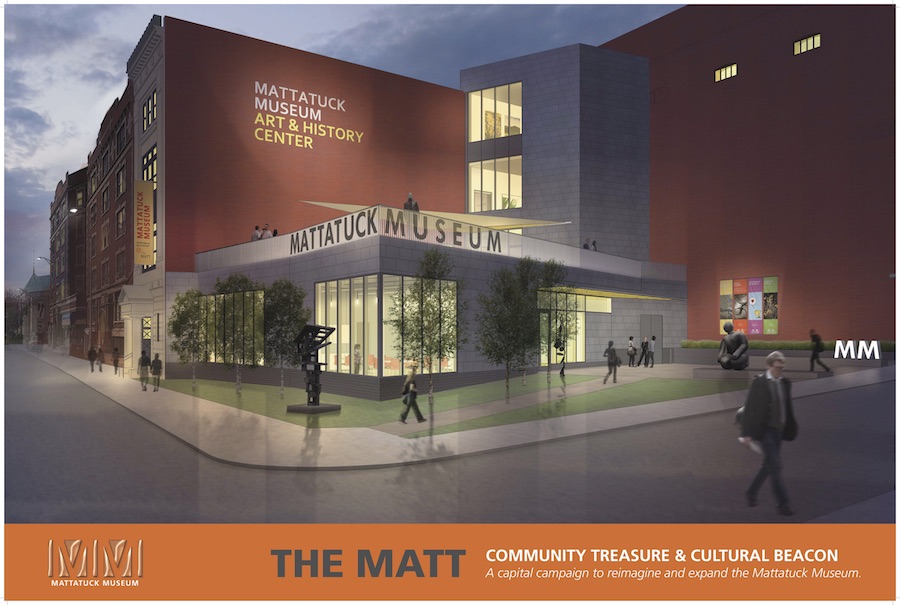
Arts & Culture | Waterbury | Museums
Sleek new studio spaces, with expanded programming for kids and families. New galleries just for large-scale sculpture, where visitors will have to raise their eyes to the roof to take in the work around them. A rooftop terrace, from which Waterbury’s main green will sprawl out in the center of the town. A whole new entrance, through which attendees will be transported to a new cultural realm. And a cafe to slow down, and digest all the changes.
That’s the new vision for Waterbury’s Mattatuck Museum, nestled on the town’s main drag just blocks from the historic Palace Theater and Waterbury’s Town Green. Tuesday morning, Museum Director Bob Burns members of a “Campaign Leadership Council” announced an $8 million capital project dedicated to expanding and renovating the museum.
The announcement ushers in a final public phase of longtime funding efforts for the project. Before announcing the campaign Tuesday, the museum has been working with a Campaign Leadership Council comprising current and former MATT board members, staff and volunteers to raise some of the funding for the project. Since 2016, the council has been able to raise $6.6 million for the expansion, with funding from private donors, nonprofit foundations and corporate gifts as well as funds from Connecticut's Department of Community and Economic Development (DECD), the State Bond Commission, and Waterbury Development Corporation.
“We believe in Waterbury and its future,” said Burns in a press release sent Tuesday afternoon. “We pledge to use our strength as a cultural beacon to bring an expanded audience of visitors to downtown.”
The campaign is part of efforts to revitalize both the museum, dedicated to art and history in the area, and the city of Waterbury. In 2014, the museum drafted a three-year strategic plan that included new attention to accessibility, stewardship, community engagement, and educational programming. Specifically, the museum discussed expanding its institutional footprint, declaring an intention to work with other economic development engines in the area “to lure restaurants, bars, and entertainment businesses to Downtown Waterbury.”
In the years since, the museum has dug into its vision for expansion, while watching an influx of both state and federal dollars come into the city for downtown and neighborhood revitalization projects. After working with Boston-based Ann Beha Architects (ABA) on a “space use survey” in 2014, the museum embarked on a 2015 renovation of its gallery space and performing arts center. It was followed by a major renovation plan also from ABA in 2016.
In implementing that plan, the museum is working with New Britain-based Downes Construction, known for its work on Central Connecticut State University and several hospitals in the state. Tuesday, Burns praised the support that the museum has received from both Waterbury Mayor Neil O'Leary and state legislators Joan Hartley and Jeff Berger, who represent the district in Hartford.
The renovation and expansion, which is slated to begin on 10,000 square feet of the museum in spring of next year, includes changes to HVAC and climate control systems; plans for two additional studio spaces for expanded school tours, family and adult programming; more exhibition space; increased parking, and an entirely new entrance to the museum. The renovated museum will also feature a new elevator that “is better equipped to accommodate large-scale, high quality traveling exhibitions,” according to the press release.
Once architects have broken ground next year, the museum estimates that the renovation will take 12-15 months to complete. During that time, it will manage a temporary museum at the nearby Rose Hill Mansion on the city’s Prospect Street. Once it has reopened, Board President Mary Rosengrant-Chiappalone estimated that it will bring an additional $1 million into downtown Waterbury’s economy.
The campaign dovetails with the MATT’s expanded and sustained focus on community outreach and inclusion. Earlier this year, it released another three-year strategic plan, outlining a commitment to community-focused programs, exhibitions, and materials for multilingual, multiracial, and multigenerational audiences.
“This thoughtful expansion will enable us to broaden our reach and serve a larger audience of visitors that will benefit the City and our community,” Burns wrote in that report. “For the Mattatuck to continue in its effort to be a destination museum, it must continue to create exhibitions, programs and events with strong allure to attract local and regional audiences.”
For more information on how to contribute to the Mattatuck Museum’s Capital Campaign contact Cyndi Tolosa, Director of Development at cyndi@mattmuseum.org or (203) 753-0381 x120. The capital campaign plan is also available online here. To find out more about the MATT’s existing exhibitions and programming, visit its website.

